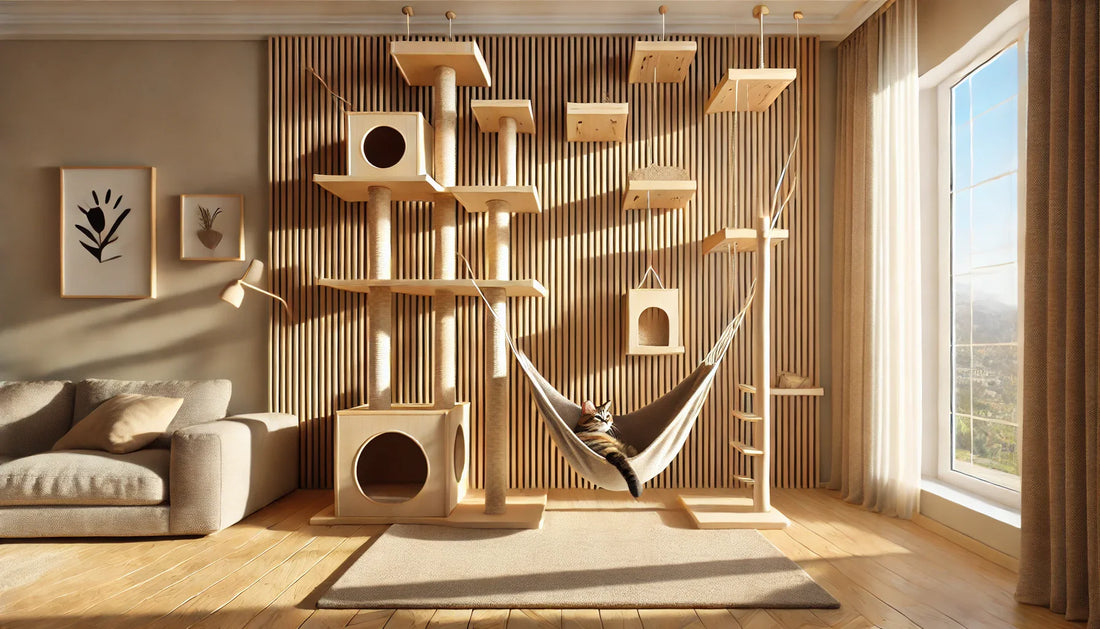
Vertical Kingdoms & Hunting Rhythms: The Complete Indoor Enrichment Architecture | Cat Emporium Store
Share
Prologue
Cats read the home in stories of altitude, route, and ritual. Square footage is secondary; topography is king. Build a world of up, through, and across—then pace it with a daily hunt–eat–groom–sleep cycle. The result is a gentler house and a cat who stops negotiating with your curtains.
1) The Three-Tier Map (copy this to graph paper)
-
Basecamp: floor-level hideouts, horizontal scratchers, toy cache, and a shallow water bowl far from food.
-
Transit: cat trees, tunnels, and staggered wall shelves that connect rooms without bottlenecks.
-
Lookouts: window perches, tall shelves, and cabinet-top beds with non-slip mats.
Rule: From any resting spot, there should be two exits (down or across) to prevent ambush anxiety—vital in multi-cat homes.
2) Scratch Science that Saves Sofas
-
Formats: Vertical poles (tall enough for a full stretch), angled ramps, and flat pads.
-
Materials: Sisal fabric for durability, cardboard for instant buy-in, seagrass for texture variety.
-
Placement: One scratcher at each transition (room entrances) + near favorite naps.
-
Reinforcement: Sprinkle catnip/silvervine periodically; reward with a single, tiny treat the moment claws hit the right surface.
3) The Ladder of Places (step heights that feel natural)
-
Start with a stable cat tree (heavy base, 20–24 in platforms).
-
Add wall shelves at 12–16 in vertical intervals; corners turn best with triangle shelves.
-
Link to a sunny window hammock; anchor into studs and test for wobble.
4) The Four-Bin Toy Rotation (15 minutes on Sundays)
-
Bin A (chase): feather wand, ribbon teaser, laser pointer rules (use walls/floor; never eyes).
-
Bin B (forage): treat balls, puzzle boxes, snuffle mats.
-
Bin C (clutch & kick): catnip/silvervine kickers, soft prey toys.
-
Bin D (sound/texture): crinkle tunnels, spring toys.
Rotate every 48 hours; novelty is 50% of enchantment.
5) Daily Rhythm (Hunt → Eat → Groom → Sleep)
-
Morning (7–10 min): Pre-breakfast wand play ending in a small feeding.
-
Afternoon (passive): Window perch + bird feeder view; puzzle feeder for a snack.
-
Evening (12–15 min): High-intensity chase in short bursts; then dinner in a slow feeder.
-
Lights-out: Lick mat or kicker for decompression; white-noise on low if the house is lively.
6) Multi-Cat Peace by Design
-
Duplicate resources: one litter station per cat +1, one water site per floor, one high perch per cat +1.
-
Avoid dead-end shelves; build loops so one cat doesn’t trap another.
7) Cleaning & Safety Cadence
-
Vacuum tree platforms weekly; wipe shelves with pet-safe cloth.
-
Inspect posts for wobble; re-tighten hardware monthly.
-
Retire shredded strings and torn fabric (ingestion risk).
8) Troubleshooting (symptom → cause → fix)
-
Sofa scratching: Missing vertical post at traffic node → add 32–36 in post; reward heavily.
-
Night zoomies: No evening hunt → 12 min wand play + dinner after.
-
Shelf avoidance: Spacing too wide → add mid-step at 12–14 in; reduce wobble.
-
Resource spats: Single exit per perch → add a second shelf or ramp; duplicate bowls.
FAQ
Q: My cat “doesn’t play.”
A: Change the motion, not just the toy—fast–slow, ground–air, hide–reveal. End sessions before boredom.*
Q: Small apartment?
A: One tall tree + three wall shelves + a window perch outperform a room of floor toys.
Epilogue / CTA
Compose altitude with cat trees, wall shelves, window hammocks, tunnels, and multi-format scratchers from Cat Emporium Store. Pace the day with a hunt that ends in dinner, and watch peace arrive on schedule.
